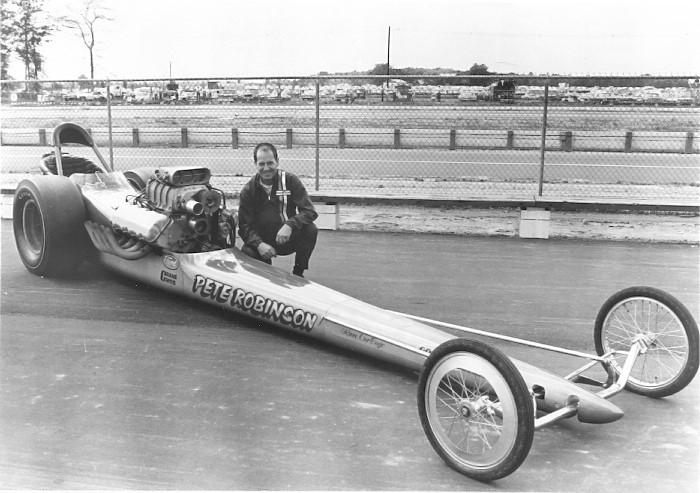Pete Robinson, Part 4
Part 1: http://www.dragracingonline.com/features/2014/xvi_11-robinson-1.html
Part 2: http://www.dragracingonline.com/features/2014/xvi_11-robinson2-1.html
Part 3: http://www.dragracingonline.com/features/2015/xvii_3-sneakypete-1.html
Part 4 concludes the series by Jim Hill.
Goodbye Gasoline, Hello Nitromethane
 Top Fuel had long been a staple in California, and although NHRA banned the use of nitro/alcohol for several years, the class had been run at the Winternationals in 1963, and at The Nationals in 1964. The huge popularity of Top Fuel racing was not lost on Pete and Bill. Both knew it was time to make the move to Top Fuel. Pete later noted that after a hard-fought Top Gas win at a major event he got only a few lines mention in Hot Rod Magazine. The Top Fuel winner received several pages. Top Fuel also paid more in winning and round money, and sponsors wanted their product exposed in Top Fuel.
Top Fuel had long been a staple in California, and although NHRA banned the use of nitro/alcohol for several years, the class had been run at the Winternationals in 1963, and at The Nationals in 1964. The huge popularity of Top Fuel racing was not lost on Pete and Bill. Both knew it was time to make the move to Top Fuel. Pete later noted that after a hard-fought Top Gas win at a major event he got only a few lines mention in Hot Rod Magazine. The Top Fuel winner received several pages. Top Fuel also paid more in winning and round money, and sponsors wanted their product exposed in Top Fuel.
The higher costs of racing at the top level required sponsorship, even for a few thousand dollars. Product-only support was highly valued, especially when the items were consumed in quantity by hungry, nitro-gulping engines.
So, why not Funny Car? Although in a few short years Funny Cars would eclipse Top Fuel in popularity, they were still an embryonic novelty in 1964 and ’65.
Pete decided to further his career and make the move to Top Fuel after Ford promised support. He ordered a new 154-inch Woody chassis with mounts to accommodate a Ford 427 SOHC engine.
The 427 ‘Cammer had already made its mark in A/Factory Experimental and outlaw match racing as early as 1964, but with fuel injection and nitro, unblown. The engine’s acceptance soared in ’66, when Lincoln-Mercury (guided by Al Turner) introduced the Logghe tube chassis, flip-top fiberglass bodied Mercury Cyclones. “Dyno Don” Nicholson and “Fast Eddie” Schartman were nearly unbeatable that year. Other Mercurys and Ford Mustangs followed. Dodge, Plymouth and Chevy competition were soon all running tube chassis, and then supercharged engines. Logghe, Don Hardy and other chassis shops were swamped with orders.
Although Pete would soon be joining the ranks of ‘Cammer-powered racers in a Top Fueler, his Top Gas career had to work its way to completion, including a final Top Gas win at the fabled Bakersfield March Meet. Held north of Los Angeles at Famoso, California, the annual “March Meet” was a staple event for dragsters. Being in the backyard of its SoCal birthplace, Top Fuel was the headline event but Top Gas carried an attractive cash payoff and big prestige. George Bolthoff, the “Freight Train”, Jimmy Scott, Tommy Larkin and others filled the field.
Pete ran the new Chevy-powered “Tinker Toy” without ballast. Floating across the scales at just 875 pounds, he hustled the new flyweight flyer to the win.
The extended California winter stay also netted him a UDRA (United Drag Racers Association) Top Gas win at the historic old Lions Associated Drag Strip, next to the Port of Long Beach. Pete recorded a record 8.14, a tribute to Lions’ famous “heavy air” and Pete’s savvy.
Pete’s Lions appearance was not without incident. A gusty top-end crosswind grabbed his chute and left the new Tinker Toy’s front-end crumpled. Luckily, Woody Gilmore’s shop was nearby, and Pete’s chassis was reborn as “Tinker Toy Too”.
At the ’64 NHRA Nationals, he won the AA/Gas Dragster class, then sat out eliminations of the quick eight cars. In the Top Gas Eliminator final Pete lost a close race to Portsmouth, Ohio’s Gordon “Collecting” Collett, one of the era’s most successful Top Gas racers.


